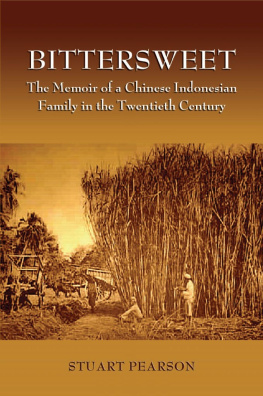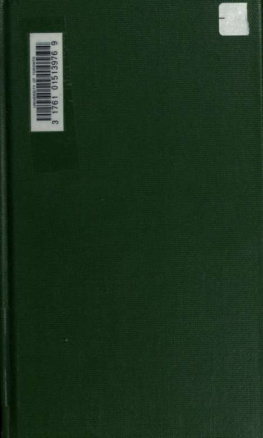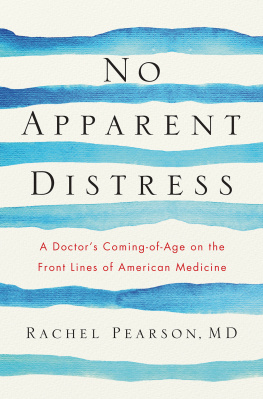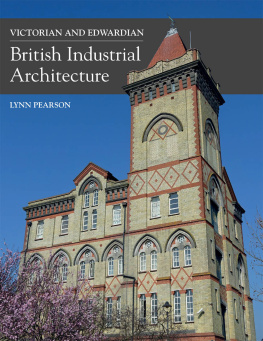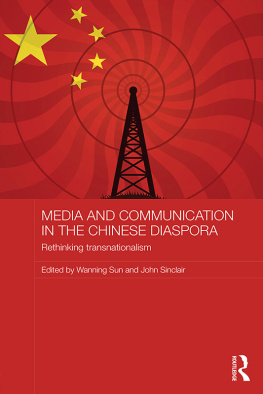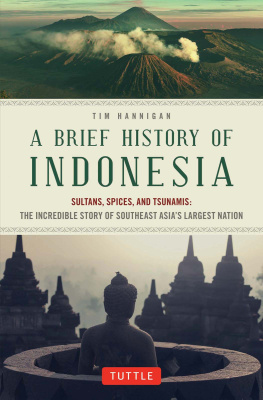B ITTER S WEET

First published by:
NUS Press
National University of Singapore
AS3-01-02, 3 Arts Link
Singapore 117569
Fax: (65) 6774-0652
E-mail: nusbooks@nus.edu.sg
Website: http://www.nus.edu.sg/npu
ISBN 978-9971-69-425-8 (Paper)
eISBN 978-9971-69-710-5
Published for distribution in the United States by:
Ohio University Press
Ohio University Research in International Studies
Southeast Asia Series
Athens, OH 45701, USA
Executive editor: Gillian Berchowitz
Area consultant: William H. Frederick
Website: http://www.ohioswallow.com
ISBN-10 0-89680-264-7
ISBN-13 978-0-89680-264-3
All rights reserved. This book, or parts thereof, may not be reproduced in any form or by any means, electronic or mechanical, including photocopying, recording or any information storage and retrieval system now known or to be invented, without written permission from the Publisher.
2008 | Stuart Pearson |
E-mail: stuart@bigpond.com |
National Library Board Singapore Cataloguing in Publication Data
Pearson, Stuart, 1952
BitterSweet : the memoir of a Chinese Indonesian family in the twentieth century / Stuart Pearson. Singapore : NUS Press, c2008.
p. cm.
Includes bibliographical references and index.
ISBN-13 : 978-9971-69-425-8 (pbk.)
1. Sudibjo, An, 1912- 2. Sudibjo, An, 1912- Family. 3. Chinese Indonesia Biography. 4. Chinese Indonesia Social life and customs 20th century. 5. Chinese Indonesia History 20th century. I. Title.
DS632.3.C5 |
305.89510598 dc22 | OCN225854023 |
Cover: Sugarcane in East Java, 1910 (KITLV #2440)
Printed in Singapore
To the two people who made this book possible,
An and Eddie Sudibjo
List of Figures

List of Illustrations

Foreword

It gives me much pleasure to recommend this unusual book to anyone interested in the modern history of the ethnic Chinese in Southeast Asia and specifically in Indonesia.
Most books about Chinese Indonesians address societal issues in the broad rather than the refracted experiences of individual lives. Social scientists and historians tend, almost inevitably, to make generalizations about Chinese Indonesians as a minority group. These can easily reinforce the popular negative stereotypes which so often distort the lived experience of individual people. Personal memoirs help to provide an antidote to the poison of these stereotypes.
The few books which do focus on individual lives of Chinese Indonesians are usually autobiographies (or biographies) of men who have played a prominent role in politics or business. Very little has been written by or about individual ethnic Chinese women. The memoirs of Koo Hui-Lan and Queeny Chang are the best-known of those available in English.
This volume is a welcome addition to the field. It is a memoir of a Chinese Indonesian family in the twentieth century. Described as a family history, it is based on extensive interviews which Stuart Pearson has edited and recast into first-person narratives.
The principal voice is that of his mother-in-law, An Utari Sudibjo, who was born in the east Javanese town of Kediri in 1912 under the name Tan Sian Nio. When Pearson began his project, An was more than 90 years old and her husband Eddie Sudibjo was in his eighties. One of the interesting aspects of the book is the unusually long span of Ans memories. Her narrative is punctuated by great events that influenced the course of her life: the vicissitudes of the sugar industry in Kediri in the 1920s; the economic depression of the 1930s; the Japanese invasion and occupation of Indonesia in 1942; the Indonesian struggle for independence after the Japanese surrender in 1945; the dislocation caused by the campaign against Dutch economic interests in 1957; the inflation and political instability of Sukarnos Guided Democracy from 1959 to 1965; and the subsequent frightening transition to Suhartos New Order. Ans account of her life reflects upon these fast-changing contexts.
She was born and grew to adulthood in what was then the Netherlands Indies. Despite graduating from the Dutch Chinese elementary school (Hollandsche-Chineesche School, or HCS) in Kediri with results that ranked her second in the entire colony, she was unable to follow her older brother into a prestigious Dutch secondary school (Hogereburgerschool, or HBS) because of her fathers bankruptcy. At the age of twelve, An was sent instead to the Dutch Chinese Teachers College (Hollandsche Chineesche Kweekschool) in Batavia, the colonial capital. After five years of study there she qualified as a primary school teacher with the additional distinction, shared with only one other student in her cohort of about thirty, of qualifying to teach in the European elementary schools (Europeesche Lagere School, or ELS) as well as the HCS. In the following three years, while teaching at the HCS in Jember in East Java, she successfully studied by correspondence to become a high school teacher of mathematics and physics. She was active in the teachers union (Nederlands Indisch Onderwijzers Genootschap, or NIOG), rising to be national Secretary in 1940.
In 1939 she became deputy principal of the HCS in Salatiga and soon afterwards, while still in her twenties, was promoted to be principal of the school when the Dutch principal was called up for military service. This was remarkable progress for a young woman in a male-dominated colonial society.
The Japanese occupation of Indonesia interrupted Ans stellar career. Soon after the Dutch surrender in March 1942, all Dutch-medium schools were compelled to close. An locked up her school and made her way to Tanggul (near Jember), where her father was by now supervising six rice mills for a cousin. Accompanying her on this journey was her future husband Eddie (born Kang Hoo Bie), who had been a boarder at her primary school in Jember and was now a student at a high school in Solo which had also been forced to close. She soon found herself responsible for feeding a detachment of Japanese soldiers who were billeted in Tanggul. In 1944 she married Eddie, who was nine years her junior. Their son John (one of the voices in the book) was born in Jember in October 1945, shortly after the Indonesian declaration of independence. In mid-1947 they escaped from the insecurity of East Java and settled in Jakarta, where their second child Ingrid (later to be Pearsons wife and another voice) was born.
An resumed her career in Jakarta teaching mathematics and physics at a combined junior and senior high school, where she was soon promoted to principal when the Dutch head resigned to leave Indonesia. As Ingrids birth approached, she had to stop classroom teaching and was deployed to a special task force translating school text books from Dutch into Indonesian. An was responsible for the translation of the mathematics and physics textbooks, which she then used when in August 1949 she returned to active teaching of mathematics and physics to trainee teachers at a new senior teachers college (

